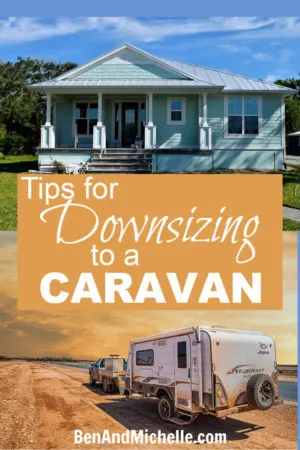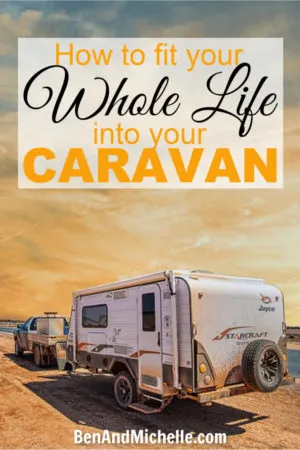Are you dreaming of selling everything, buying a caravan and hitting the road; but worried about if downsizing to a caravan is even possible for you and your family?
Are you left with the question of, “what do I do with all my stuff?”
Downsizing from a house to a caravan can seem like a daunting task, but here’s some tips to help you in the process.
It starts with decluttering
To me, downsizing absolutely starts with decluttering. Since once you’ve decluttered, you’re about 90% of the way to finishing your downsizing anyway!
We’ve moved country twice now, first time was moving back to New Zealand, where we took just two large suitcases and two small suitcases back with us.
And then 7 years later, moving back to Australia again. Again with just a couple of large suitcases.
So we’re reasonably adept at this whole decluttering and downsizing thing now.
I’ve found that for me, downsizing needs to be a process that I go through over at least a few weeks. I don’t like having to downsize in a rush, but that’s just me.
In all of my downsizing/decluttering, I like to go through the process in this order:
- Scan all paperwork
- Throw away
- Sell
- Give away
- Store
1. Scan all paperwork & photos
Paperwork is probably the most annoying part of life! I hate it how paper is still such a big part of our lives, with everything from invoices, statements, contracts, information products, warranty cards and everything just cluttering up our lives.
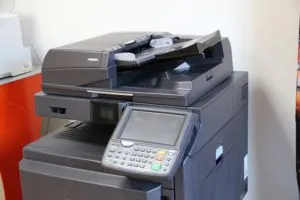 But they’re important, that’s why we hold on to them.
But they’re important, that’s why we hold on to them.
The easiest (and most efficient) way to deal with all of it, is to scan everything that you want to keep, and toss the paper.
If you have a photocopier/scanner/printer at your work, you could use that to scan all your documents. You’re not printing anything, just scanning and sending it to yourself. It’s heaps quicker on the office photocopier that has a document handler, rather than doing it one by one on your scanner at home.
Then store it in Dropbox, Google docs, Evernote or some other cloud based storage system. Not only does that make it easy to access from any device, you’re not limited to keeping it in one physical location like a computer, hard drive or USB stick.
You can organise your files however you want, but I try to stick to a naming convention that makes looking for them a bit easier.
I use something like: Name_Item_Date.
For example, a scan of the front and back of my Australian drivers license will be:
Michelle_ AU Drivers Licence front_Exp July 2029.jpg
Michelle_AU Drivers Licence back_Exp July 2029.jpg
Caveat to the throwing out of the original – I scanned things like our birth certificates, marriage certificate and all that stuff… but I didn’t throw out the original. I’m sure that’s obvious, but just in case it isn’t, don’t throw out the important stuff!! Things like wills, contracts/agreements, identity documents and anything else where you will need to keep the original.
Photos
Scanning my photos is the one thing that I haven’t got round to doing.
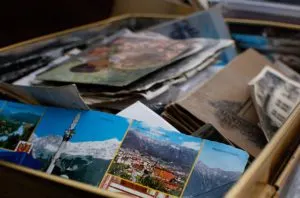
I have a big box of photos from my childhood, right up to my 30th birthday and everything in-between. (Yes, yes, all before digital cameras really became a thing).
At the time I was going to send them off to a photo place to be scanned, but it was going to cost a bomb.
So I did nothing instead.
Now you can get some pretty good apps on your phone which you can use to take photos of your photos. When we next go back to New Zealand I’ll finally get round to digitising those photos and be able to get rid of a big, heavy box from storage.
2. Throw away
I find that the easiest part of this process is identifying what needs to be thrown away.
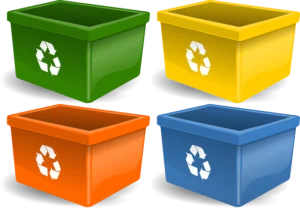 If it’s rubbish, just chuck it out.
If it’s rubbish, just chuck it out.
Put it in the recycling if possible, but get it out of your home.
Our society already has such a throw-away mentality so I’m not advocating just throwing everything away, I’m talking about getting the rubbish out of the way first, so that you can then sort everything else out into whether you’re going to sell, give away or store it.
3. Sell
If you can get money by selling the item, then by all means, do that first!
It may require some effort on your part, cleaning it up, fixing it, posting it online and then organising delivery; but if it will bring in enough money to make it worth all your time and effort, then you may as well.
4. Give-away
I’m more likely to give away my stuff than sell it, mainly because I just can’t be bothered with all the work involved in selling something, when a charity could make some money from it instead.
I figure that if it’s good enough for me to sell, then it’s good enough for me to give to them. I’ve seen plenty of times where people are just giving their junk to St Vinnies or the Salvos, but my criteria is that it must be stuff that I would be willing to sell… if I could be bothered.
So, to be honest, a lot of our stuff ended up going to the dump. Not ideal, but I talk a little bit more about that in the ‘Stop the Flow’ paragraph further down.
5. Store
Personally, I think this should be your last resort… but there is always the option of storing some of your belongings if you don’t want to take them on the road with you, but you also don’t want to get rid of them.

This could be a commercial storage unit, a few boxes in your parents garage or a locked shed at the house you own, but are renting out. (Onus is on you to check for insurance requirements etc).
It seems crazy to me, to pay for a storage unit, but I can’t be all judgey-pants about people who do that, because I have a few boxes stored in the garage at my grandparents home. They’re sentimental items that I’m not ready to part with (and don’t think I ever will be) but I certainly don’t need to be carrying around a Turkish rug or a beautiful dinner set!
Sentimental Items
Speaking of sentimental items… figuring out what to do with items that have sentimental value to you, is the hardest part of downsizing! (Hence the reason why I still have a box of them gathering dust in a garage.)
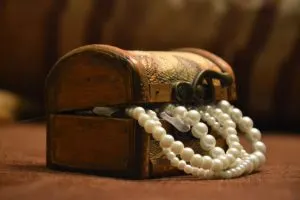 My friend Ashley over at RVinspiration.com has a post on what you should do with sentimental items.
My friend Ashley over at RVinspiration.com has a post on what you should do with sentimental items.
My favourite idea of hers, is to give the item to a friend or family member that would hold the same sentimental value as you. That way, whenever you go and visit them you’ll be able to see the item. Or maybe just knowing that the item is still being treasured in the same way as you did, will be enough.
See Ashley’s other ideas over here: What to do with sentimental items when downsizing
Stop the flow
In all of my reading and experiencing decluttering, minimalism and downsizing; I came to the realisation that, for many people (myself included), the acquiring, accumulating and storing of ‘stuff’ has a psychological hold on them.
I remember when we were living and working in Auckland, life had become quite boring and dull, and sometimes on a Friday night I would suggest to Ben that we go to Kmart and see what we needed to buy and we’d grab some dinner while we were out.
 Kmart is cheap, so I’d get a little buzz from buying something but without taking a big hit to the bank account. I’d buy a kitchen drawer organiser, or some hair products, or a cheap handbag… not because I actually needed these things, but because it made me feel good for a while.
Kmart is cheap, so I’d get a little buzz from buying something but without taking a big hit to the bank account. I’d buy a kitchen drawer organiser, or some hair products, or a cheap handbag… not because I actually needed these things, but because it made me feel good for a while.
So while I was going through the process of decluttering, I also needed to check in with myself about why I was buying these needless things, and what I could do instead.
You may find that you need to go through a similar process.
Take your time
Our last tip for downsizing is to take your time.
It’s a process and it doesn’t have to be all done in one weekend. Unless of course, you’ve left things to the very last minute and now you’re in a mad panic!
As soon as we’d decided to sell up and hit the road, I started scanning all our documents and storing them in the cloud.
I also did a clean out of every cupboard, drawer and wardrobe in the house. Some things were quickly identified as rubbish and thrown out. (Doing it over time also meant that we didn’t overload our big green bin.)
Then, I’d go back later and have another big clean out.
I enjoy this process, so it’s not something that I would leave until the last week. Cupboards and drawers got cleaned out whenever I had some free time, or more likely when I was a bit stressed out or grumpy… cleaning out a drawer is therapeutic for me and would feed my excitement about our trip. (Yep, call me crazy if you want.)
Those that have read Marie Kondo’s ‘The Life-Changing Magic of Tidying Up’ will know that she advocates de-cluttering of one area (e.g. your clothes) all in one go. While there’s logic in that, since you deal with the whole thing just the once and you’re not left with piles of clothes all over the place; I find that taking my time with the process works better for me.
Likewise, you’ll need to figure out what works best for you, your personality and your circumstances.
Have you already gone through the process of downsizing to a caravan? How did you do it? Do you have any other tips you can share with us? We’d love to hear them!
Pin for later!
